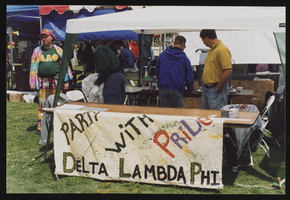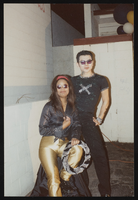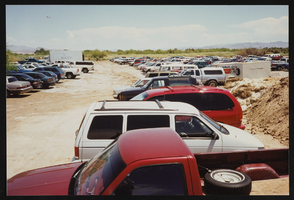Search the Special Collections and Archives Portal
Search Results
Louis Conner oral history interview
Identifier
Abstract
Oral history interview with Louis Conner conducted by John Grygo on March 22, 2013 for the African Americans in Las Vegas: a Collaborative Oral History Project. In this interview, Conner discusses his personal history and growing up in Tallulah, Louisiana. He talks about moving to Las Vegas, Nevada with his family for job opportunities in the late 1950s. Conner describes his employment at the Stardust Hotel, segregation, and living in West Las Vegas. He then talks about integration in the mid-1960s, Jackson Street entertainment, and the changing demographic of the Westside. Lastly, Conner discusses the development of Las Vegas, families moving out of the Westside, and new businesses in the area.
Archival Collection

Delta Lambda Phi booth at Gay Pride: photographic print
Date
Archival Collection
Description
Image
Emmanuel Ortega oral history interview
Identifier
Abstract
Oral history interview with Emmanuel Ortega conducted by Monserrath Hernandez, Maribel Estrada Calderon, Elsa Lopez, Barbara Tabach, and Laurents Bañuelos Benitez on 2019 for the Latinx Voices of Southern Nevada Oral History Project. Emmanuel Ortega was born in Artesia, California and was raised in Ciudad Juárez, Mexico before moving to El Paso, Texas with his family at the age of thirteen. In 1998 his family relocated once again from El Paso to Las Vegas, Nevada where his father joined the Carpenters Union. They settled in Green Valley and he began attending a hybrid community college and high school program allowing him to obtain college credits. He continued at the College of Southern Nevada for two more years where he was a photography major and later transferred to the University of Nevada, Las Vegas (UNLV) where he studied art history. He moved back to Las Vegas in 2011 where he began teaching at UNLV and received a PhD in Ibero-American colonial art history from the University of New Mexico in 2017. He is the co-host of the podcast "Latinos Who Lunch" where hosts discuss pop culture, art, and issues of race, sex, and gender in the Latinx community.
Archival Collection
Maxine Butler oral history interview
Identifier
Abstract
Oral history interview with Maxine Butler conducted by Frank Johnson on April 22, 2016 for the African Americans in Las Vegas: a Collaborative Oral History Project. In this interview, Butler discusses her early life in Jonesboro, Louisiana. She talks about moving to Las Vegas, Nevada in 1965, the Westside, and businesses on Jackson Street. Butler recalls working at The Cove as a cocktail waitress, the reopening of Moulin Rouge Hotel, and the African American community on the Westside. Later, Butler discusses her involvement at Greater Evergreen Missionary Baptist Church, the importance of church to the African American community, and compares church life in Jonesboro and Las Vegas. Lastly, Butler talks about changes in the Westside.
Archival Collection
Charlotte Ellsworth oral history interview
Identifier
Abstract
Oral history interview with Charlotte Ellsworth conducted by Jane Ellsworth Olive on March 22, 1977, December 26, 1980, December 28, 1981, and August 06, 1987 for the Ralph Roske Oral History Project on Early Las Vegas. In the span of four interviews, Ellsworth discusses her family’s history, the growth of Henderson, Nevada, working at the Basic Magnesium Plant, and life during World War II. She also talks about war bond drives, the Oakey Theaters, Nevada Chamber of Commerce, "western" clothes, and hotels like the Flamingo Hotel and the Riviera Hotel. She then describes visiting places like Canada, Salt Lake City, Utah, Washington, D. C., and San Francisco, California.
Archival Collection

Pride Street dancers at the Gay and Lesbian Community Services Center in Las Vegas, Nevada: photographic print
Date
Archival Collection
Description
Image
Studies for Gay Pride logo, 2000
Level of Description
Archival Collection
Collection Name: Las Vegas Bugle Collection on Lesbian, Gay, Bisexual, and Transgender History
Box/Folder: Box 03
Archival Component
"Nevada Gay Times," memoranda, 1985
Level of Description
Archival Collection
Collection Name: Las Vegas Bugle Collection on Lesbian, Gay, Bisexual, and Transgender History
Box/Folder: Box 01
Archival Component

Parking lot at Gay Pride: photographic print
Date
Archival Collection
Description
Gay Pride 1997 (Dennis McBride, photographer) Gay Pride 1997 at Sunset Park; parking lot.
Image
Harry Mortenson oral history interviews
Identifier
Abstract
Oral history interviews with Harry Mortenson conducted by Claytee D. White on April 08, 2014, April 22, 2014, and May 06, 2014 for the Boyer Early Las Vegas Oral History Project. In the first interview, Mortenson discusses his personal background, working at Los Alamos National Laboratory in New Mexico, and arriving to Nevada to work as a nuclear physicist at the Nevada Test Site. Mortenson describes his work and recalls anecdotes from his employment. He then talks about his company, Sigma Scientific, and explains the different projects where he worked as a consultant. In the second interview, Mortenson discusses the methods of transportation used to arrive to the Nevada Test Site, his involvement with different organizations, and his tenure in the Nevada State Legislature. In the final interview, Mortenson discusses the device he built to take photographs of the nuclear reactor cores at Las Alamos National Laboratory, and explains how that device worked.
Archival Collection
